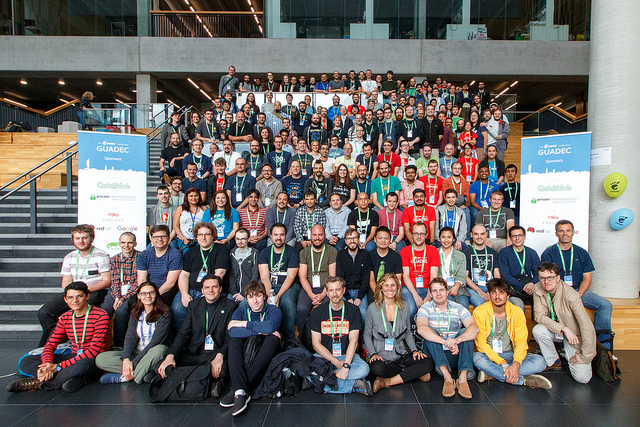NOTE: This is a blog post I kept as a draft right after GUADEC to reflect on it and the GNOME project but failed to finish and publish until now. Forgive any outdated information though I think the post is mostly relevant still.
I’m on my train back to London from Manchester, where I just spent 7 amazing days with my fellow GNOME community members. Props to the local team for an amazing organization, everything went smoothly and people seemed extremely pleased with the setup as far as I can tell and the venues seemed to have worked extremely well. I mostly want to reflect on a feeling that I have which is that GNOME seems to be experiencing a renaissance in the energy and focus of the community as well as the broader interest from other players.

Peak attendance and sponsorship
Our attendance numbers have gone up considerably from the most recent years, approximately 260 registrations, minus a bunch of people who could not make it in the end. That is an increase of ~50-60 attendants which is really encouraging.
On top of that this years’ sponsorships went up both in the number of companies sponsoring and supporting the event, this is really encouraging as it shows that there is an increased interest in the project and acknowledgement that GUADEC
Comebacks
There are two comebacks that were actually very encouraging, first, Canonical and Ubuntu community members are back, and it was really encouraging to see them participating. Additionally, members of the Solaris Desktop team showed up too. Also, having Andrew Walton from VMWare around was encouraging too.
Balance was brought back to the force
Historically Red Hat would have a prominent presence at GUADEC and in GNOME in general, it was really amazing to see that Endless is now a Foundation AdBoard member, but also, that the amount of Endless crew at GUADEC matched that of Red Hat.
Contrary of what people may think, Red Hat does not generally enjoy being the only player in any given free software community, however since Nokia and Sun/Oracle retreated their heavy investment in GNOME, Red Hat was probably the most prominent player in the community until now. While Red Hat is still investing as heavily as ever in GNOME, we’re not the only major player anymore, and that is something to celebrate and to look forward to see expanded to other organizations.
It was particularly encouraging to see the design sessions packed with people from Endless, Canonical and Red Hat as well as many other interested individuals.
Flathub
It feels to me that Flatpak, and specially the current efforts around Flathub have helped focused the community towards a common vision for the developer and the user story and you can feel the common excitement that we’re onto something and its implications across the stack and our infrastructure.
Obviously, not everybody shares this enthusiasm around flatpak itself, but the broad consensus is that the model around it is worth pursuing and that it has the potential to raise considerably the viability of the Free Software desktop and personal devices, not to mention, it gives a route towards monetization of free software and Linux apps.
GitLab, Meson and BuildStream
Another batch of modernization in our stack and infrastructure. First and foremost, the GitLab migration which we believe it will not only improve the interaction of newcomers and early testers as well as improving our Continuous Integration pipeline.
Consensus around Meson and leaving autotools behind is another big step and many other relevant free software projects are jumping to the bandwagon. And last but not least, Tristan and Codethink are leading an effort to consolidate continuous and jhbuild into BuildStream, a better way to build a collection of software from multiple source repositories.
Looking ahead
I think that the vibe at GUADEC and the current state of GNOME is really exciting, there are a lot of things to look forward to as well. My main take away is that the project is in an incredibly healthy state, with a rich ecosystem of people committing entire companies on products based on what the GNOME community writes and a commitment to solve some of the very hard remaining problems left to make the Free Desktop a viable contender to what the industry offers right now.
Promising times ahead.